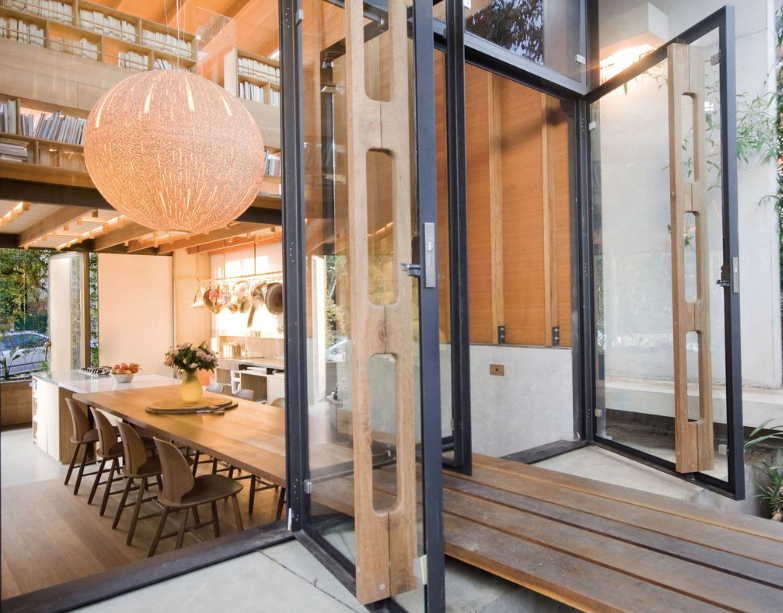
SMITHMADE Maker: Drew Heath, Architect
Creative Director Nicole Dunbar sits down with Architect Drew Heath, who collaborated on the creation of the SMITHMADE space, to talk about his practice and his passions. Alongside coming up with elegant solutions for our design hub, styling studio and store space, Drew has designed some interior elements exclusively for SMITHMADE, such as our solid wood full length grab handles.
What makes a project interesting for you?
The basic brief of a client is often quite mundane and generic – a four bedroom house, two bathrooms, entertaining deck, whatever. However, it’s the small things that make a project interesting. An example would be a house I did where the owner wanted – in addition to the generic brief – a place for their piano. So we started with the piano and the design was created around that space. Sometimes it’s a colour or hobby, a point of view, or a passion for cooking or gardening. There is always one thing that sets one person apart from another.
How big a role does environmental and social sustainability play in your buildings?
I naturally do sustainable design because I care about the environment. I don’t do fashionable things but focus more on making the functional interesting, like cross ventilation or building comfort. I also concentrate on economies of structure so my buildings are fit and not wasteful which is not the norm. In my entire career I have only ever done one or two projects with air conditioning. In my view, air conditioning is a result of dumb architecture.
What is your ultimate project?
That’s kind of difficult but I would have to say a project for myself. I’ve developed strange taste over time, see things differently and am interested in different ways to live. For example, I am currently interested in building a house that consists just of a kitchen and a table. There would be somewhere to sleep – is it under the table? There’d be a bathroom - is it outside? I see it as a celebration of indoor-outdoor space, a kitchen and a dining room that is truly a ‘living room’.
Can you tell us about the house you grew up in?
I grew up in Tasmania living in a brick and tile house of no interest at all. I made lots of Lego houses that were copies of that. It wasn’t until I went to university that I was enlightened!
Talk to us a little more about architecture that is actually ‘designed for wear’?
Some materials you can control weathering on. For example, you can control the way water flows down a building, the absorbency of a wall, does it accept moss or will it stain? It’s the controlling of the patterns, the colours and the results of the aging or wearing process. A classic example is putting copper outside and controlling the patterns it makes. It’s going to stain but how do you want it to stain?
How do you balance your passion for 100 percent handmade with the reality of your clients’ budgets?
It costs money to make things no doubt. I try and proportion the brief and budget to enable some element of the handmade. If budget is generous there is more handmade, less budget is less handmade. The key is making sure your handmade objects are in the most obvious and used places, like the dining table or front door handle.
Recycled or new?
If you can use recycled then do it. It brings stories, textures and character.
What do you mean by a hierarchy of spaces in design?
It's more interesting in a house, or in any space, when there is a different level of spacial volumes. It's universally accepted in architecture that the most important areas get the biggest space. The dining space or living has the biggest volume or height, and bedrooms are at a lower height. Generally, it’s the importance of how much a space is used that dictates its hierarchy.
You said we need to take indoor-outdoor living much further? What’s your vision here?
It could be five or six layers of covered and uncovered spaces, not one inside and one outside space. Interweave the covered and uncovered throughout the design and experiment with making functional spaces outside. Climate permitting, I would have the minimum amount of space enclosed. Sleep inside and sometimes eat inside but do bathrooms need to be enclosed? I don’t believe so.
In your view, what is the winning combination in design?
For me, it’s a balance between vertical and horizontal planes where the inside and outside space is mixed with landscape space. I like geometric objects in contrast to nature that always has an organic form. These things marry together and give you a peaceful place in the world.
What do you want to be remembered for?
I kind of like the idea of a Renaissance man, being good at everything, whether it be cooking, concreting or creativity. Being a man of many disciplines and not being scared of it.
What advice do you have for any budding designers?
Architecture is like a language, such as English. We all know how to speak our own language but it has to be more than that. With English, some people sing songs, some write poetry, some tell jokes - we all find a way to use the language creatively. Architecture is the same. A bathroom is a bathroom however it’s the details that will set you apart. Create your own doorhandles or design your own fittings from recycled or primary materials. Make a song of your work. This will set you apart from the everyday which then gives you style. The same way we recognise a singer when we hear a song, we come to recognise great style of great designers.
Also, always have one strong idea and hang onto it. In my experience, it’s like a centre-half-forward in football whose job is to kick goals. Always come up with ideas to kicks goals!



